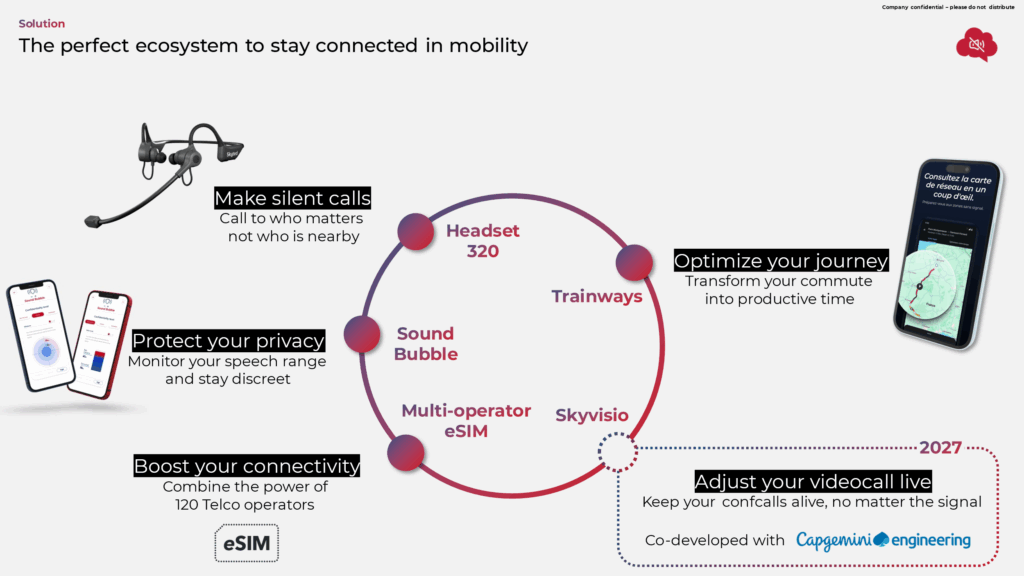Skyted’s sound-absorbing solution for facilitating virtually silent VoIP and video calls has been tweaked by management to place fresh emphasis on supporting business communications and secure conversations, including on board trains and aircraft.
During the Aircraft Interiors Expo in Hamburg, Runway Girl Network sat down with Skyted CEO Stéphane Hersen, a former Airbus staffer, to learn about the French firm’s latest update to the product, dubbed Skyted 320, and to try out the new headset.
Unlike the prior iteration which featured a mask, Skyted 320 comprises a headset and microphone that will be familiar to anyone who has worked in a call centre. Despite not completely covering the mouth, it uses noise cancellation and voice boosting technology to ensure only the voice of the caller is heard by the receiver. This also allows the user to lower their voice significantly while still being heard clearly by the person on the other end. Skyted claims this will allow for a “sound bubble” around the user.
Skyted’s previous product was focused on enabling airline passengers to make calls at their normal speaking voice without disturbing other passengers — and on selling premium products to high net worth individuals — but Skyted 320 leans heavily into confidential applications. After all, if you’re making a call in a public space, and discussing sensitive information, you might risk being overheard by a competitor.
“With this product, you can take a call at a restaurant, on a train, in an open space” without being overheard, noted Hersen. The product also uses encryption technology of up to 128-bit AES to maintain a secure connection.
Testing the Skyted 320 headset at AIX, your author found it to be quite impressive. Wearing the headset and communicating with Hersen, who also donned a headset, I could hear his voice even when he lowered his volume. Nonetheless, my phone’s recording app could not pick up the sound at all.
Colloquially dubbed “Madonna” — the pop star legend who popularized the wireless microphone headset — the Skyted 320 is much easier to wear and use than the mask product previously shown.
However, one wonders if it will see mass adoption by airline passengers, especially given that handsfree calls can be made via Bluetooth ear buds, even if the quality and confidentiality is not there.
Also, some passengers rely on the loud hum of the aircraft engines to drown out noise when making and receiving calls via inflight connectivity, even when the airline doesn’t promote or even technically allow such. Might airlines allow a carve out for Skyted 320 users?
I felt like I was giving more Britney than Madonna. Image: Fintan Horan-Stear
Any residual skepticism over the viability and usefulness of this product is about to either be disproved or justified, however, as it is being positioned as ideal for high-speed trains in Europe.
Using the new headset, passengers will be able to make calls from their seat thanks to both a multi-operator eSim service that boosts connectivity for users (across 120 European operator networks) and Skyted’s own app Trainways, which shows mobile signal quality along your train route.
The app is already available with coverage of the French high-speed rail network TGV (with the UK to follow).
Image: Skyted
For Hersen, TGV and other bullet train operators provide a natural market for Skyted 320. “[In France], you have 300,000 people using the TGV every week. Passengers from Reims, Lille, Le Mans [towns outside Paris], travelling to Paris every day… It’s pretty much a suburban ride. They can use the product to take their last call on the train before arriving home.”
He also envisages that, as Skyted 320 becomes more widespread, executives will be more likely to travel by train longer distances as they can remain connected, and work more easily. No surprise then, that the headset’s formal name is inspired by the top speed of TGV’s bullet trains (320kph), as well as the Airbus A320.
Skyted will announce a partnership with a French rail operator in the fall of 2025.
Related Articles:
Featured image credited to Fintan Horan-Stear





